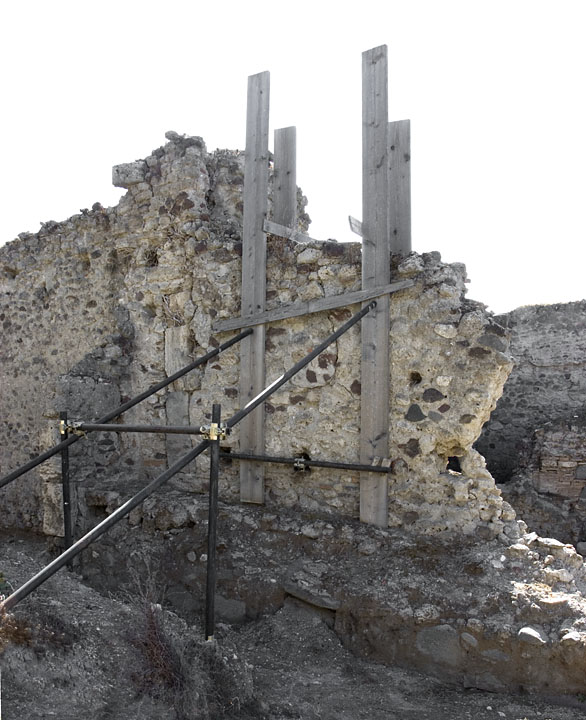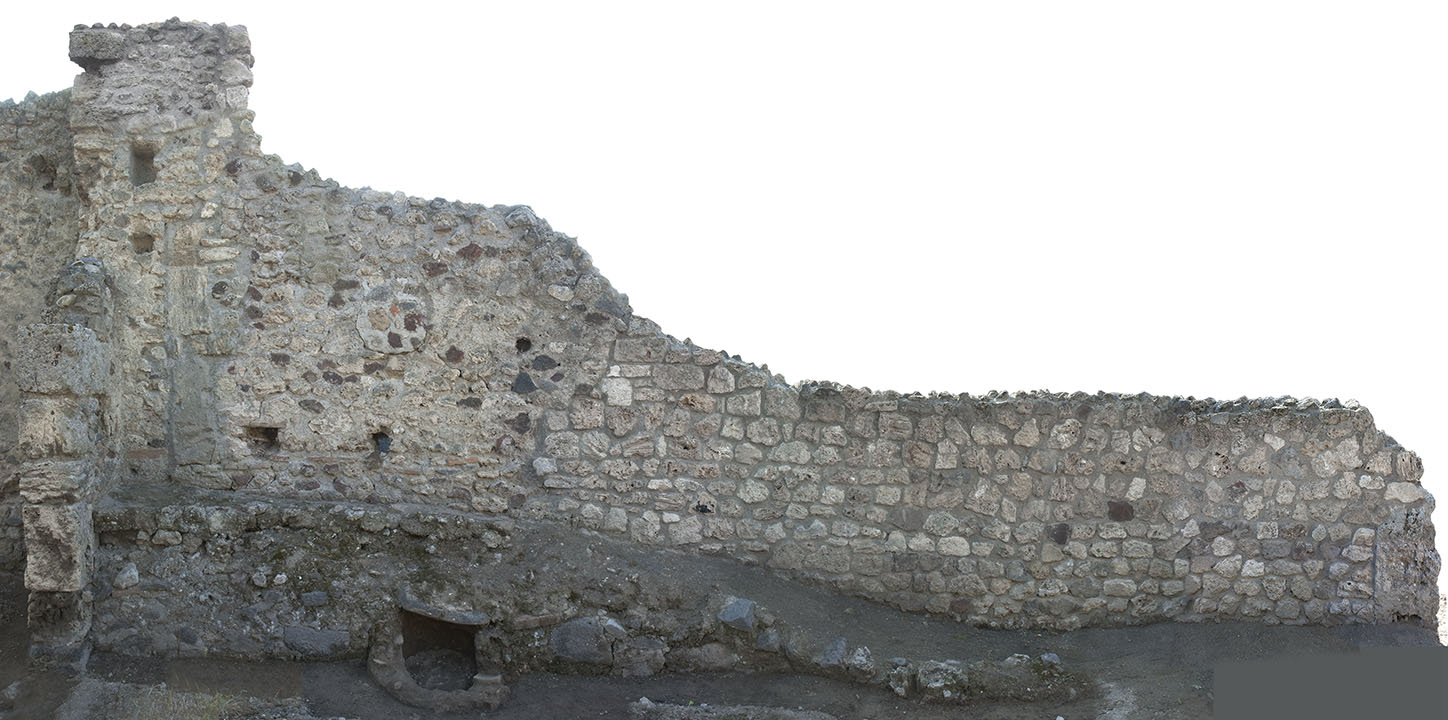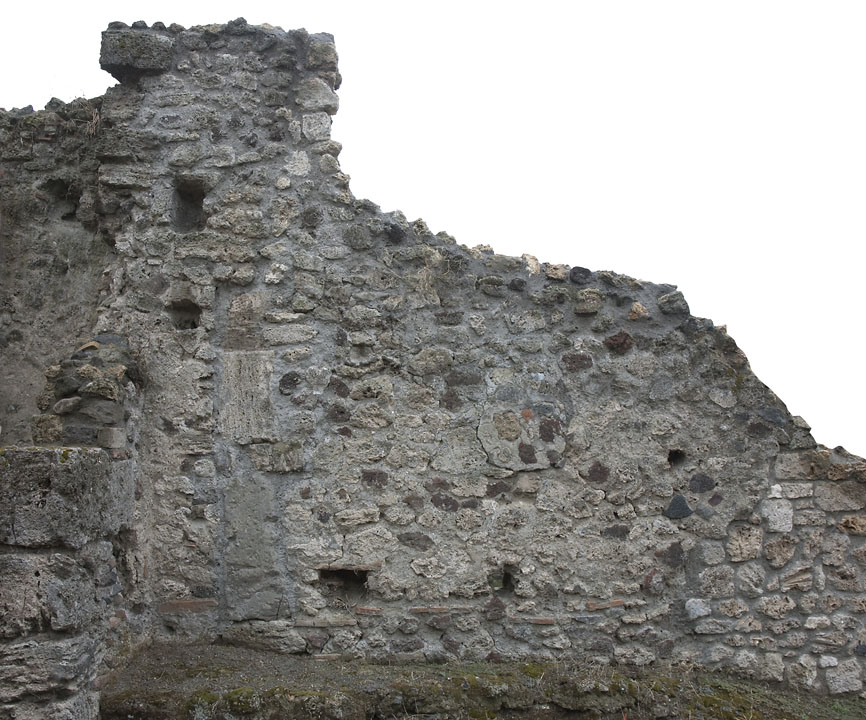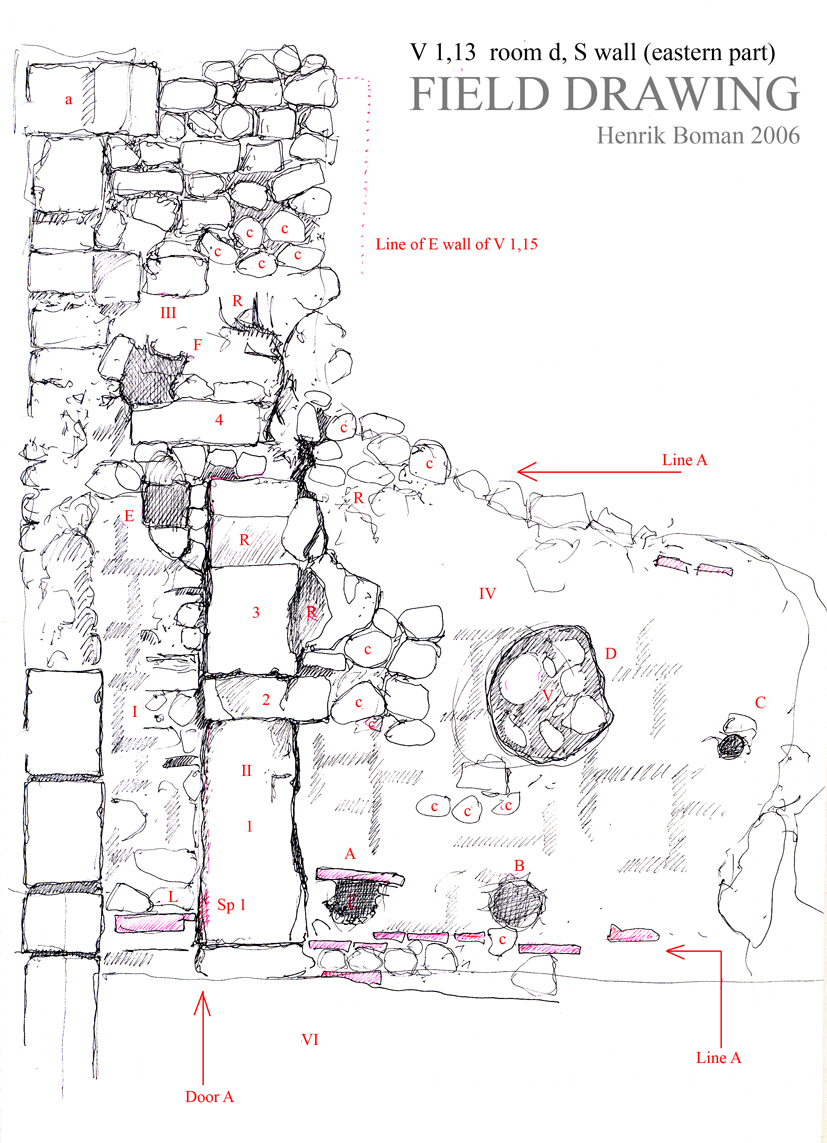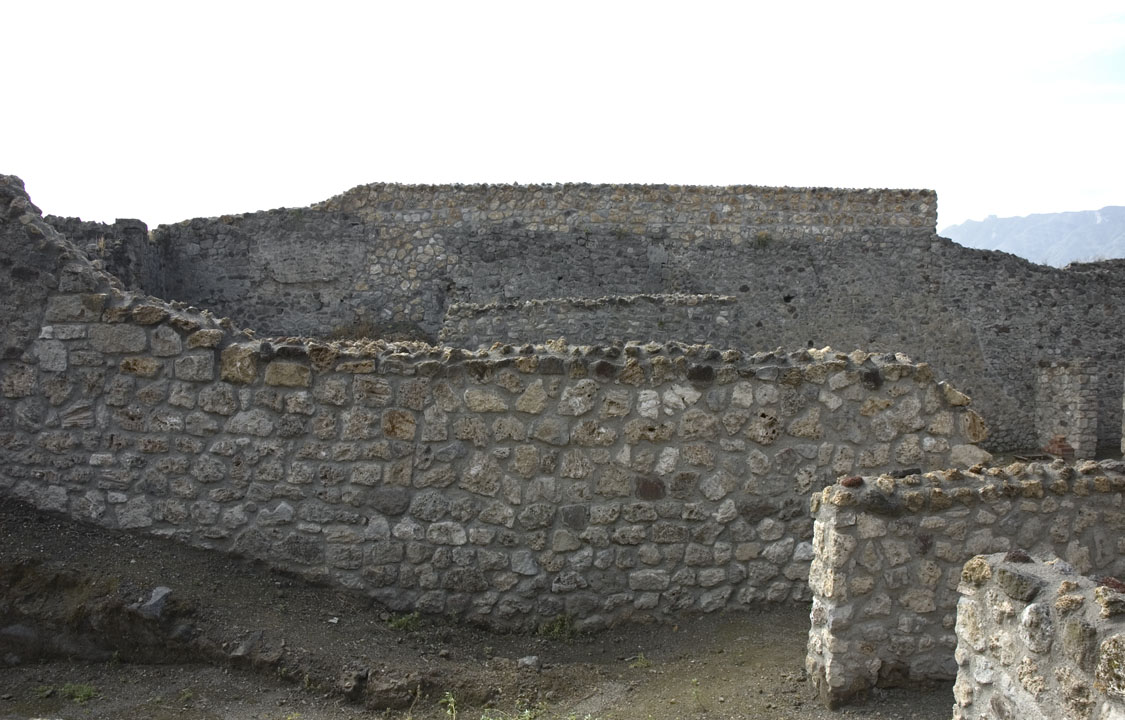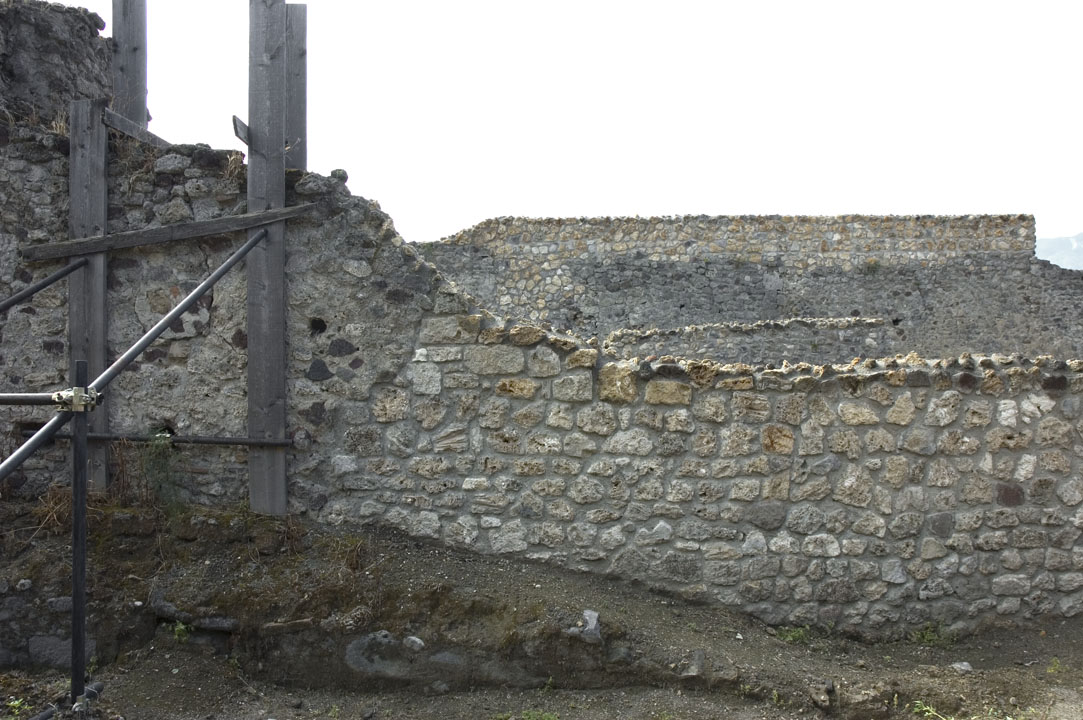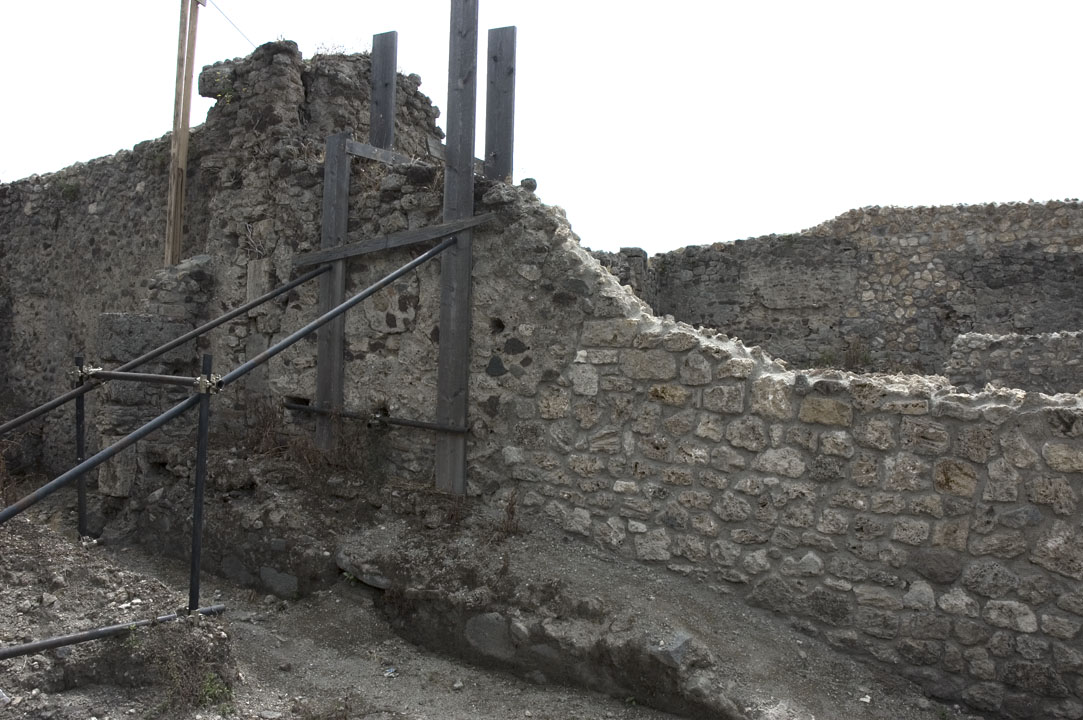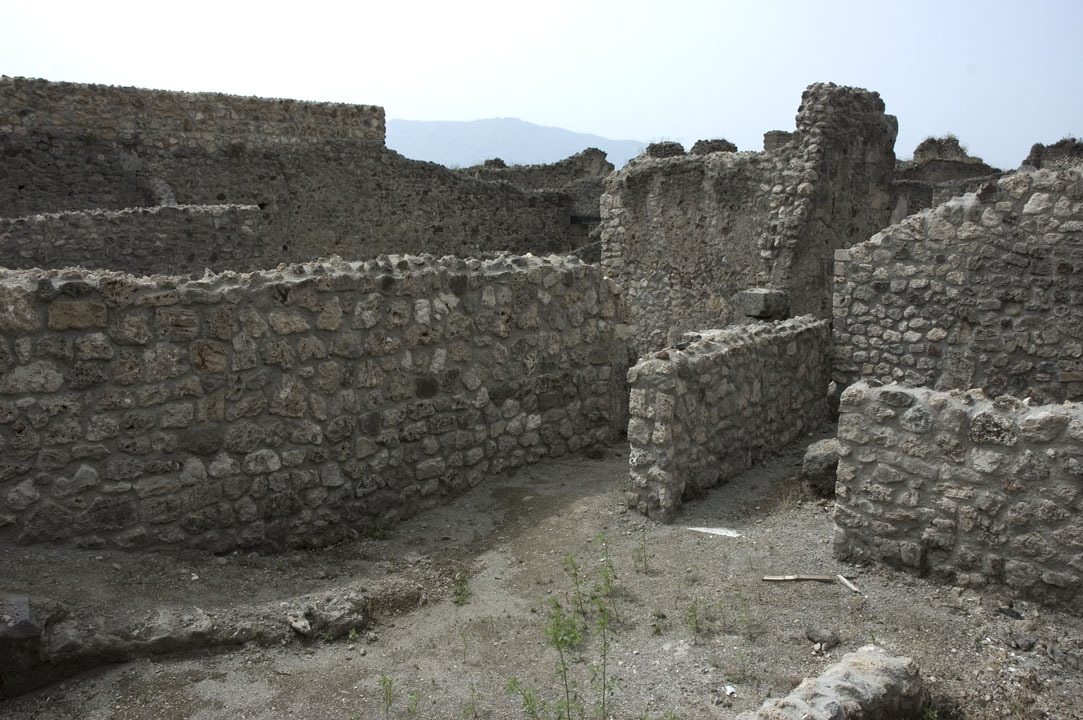South Wall
Description
Henrik Boman & Monika Nilsson
The S wall divides the caupona from the bakery V 1,14-16. There is a significant difference in height between the rear of the caupona and the bakery (c. 1-1.5m), so the wall also partially functioned as a retaining wall between the houses. The bombing in the 1940s destroyed the mid section of the wall, of which almost nothing remains. Only the easternmost part of the wall is still standing.
In room d, a long bench/basin runs along the S wall. The centre part of this was also destroyed by the bombs and the blast pushed parts of the bench inwards, into the centre of room d. Approximately midways along the bench is a cistern, partly covered by the bench, with a conduit from room f.
The wall is divided into sections (I-VI) based on appearance and specific features:
I: SE corner.
II: Orthostat structure.
III: Opus incertum wall, E part.
IV: Opus incertum wall, W part.
V: Filled-up hole.
VI: Bench/Basin/conduit.
Legends on field drawing & measurements:
Block 1. H: 0.77m; W: 0.28—0.34m
Block 2. H: 0.15m; W: 0.48m
Block 3. H: 0.82m; W: 0.35m
Block 4.
R = areas with massive roots, not possible to clean out
Sp1 = plaster on block 1 or against block 1, difficult to see due to (R)
a = large stones corresponding to the area where the S wall connected to the S wall
E = hole (beam hole?)
F = hole (beam hole?)
I. SE corner
E part by the SE corner, abuts to surface III on the E wall. Large amounts of plaster with a rectangular hole (E) in the upper part, in line with the upper block 3 in section II. Mortar has been richly applied in the area, but no plaster is preserved. The mortar of the S wall connects to the E wall with the same mortar. Tiles are found in a low area close to the bench/basin; as for the rest of the area, the majority of material in the wall consists of limestone with some cruma and one piece of black tile/pottery. The surface is smooth towards the corner, due to the mortar, but more crumbly in the area towards the orthostats (II).
II: Orthostat structure (1-4)
Orthostat structure with four blocks (1-4). Block 4 is not attached to the other three, though its location can be associated with the orthostat structure. It corresponds to the line of the E wall in the bakery.
Sanding block 1 is a dense stone, appearing to be limestone. The lying block 2 has a large piece cut out, and it extends outside the line of 1 on the W side. Orthostat 3 has what seems to be a cutting with flat bottom and curved upper part, but the area is filled with a root so it is difficult to investigate. The cutting extends through the whole horizontal length of the stone. One stone intrudes in the cutting, as it is now — this might indicate that the cutting was not intended for the installations visible in the house today. However, it might be a modern repair, since all mortar around the block has disappeared.
Plaster is found on the W surface of block 1. It might have been a open surface once, otherwise block 1 is a spoil.
III: Opus incertum wall, E part
The upper part of the wall is of opus incertum, with a hole (F), presumably for a beam or some other structure. Stones (a) are part of the W wall in room f.
The upper part of the wall is in opus incertum, with large roots impossible to remove (R). Large stones are found in the area where the now destroyed E wall met the S wall. In its present state, the stones do not seem to bound, though some of the stones (a) protrude slightly from the line of the surface of the S wall, which might indicate that the wall once bounded.
The opus incertum is built in larger stones, a majority of which is limestone, with cruma in a smaller area in the cental part.
Block 4 could be connected to the orthostat structure (II), though the hole (F) in area III is related to block 4, which functions as the lower side of the holes. Hole (F) could be connected to the hole (E) in area I since they are situated above each other.
IV: Opus incertum wall, W part
The wall to the west of area II is separated from the opus incertum wall III by the orthostat structure II. This is the larger part of the wall, from the orthostats II to the edge of the now standing remains.
The wall is built in opus incertum with generous use of mortar, which makes the surface smooth. There is a majority of limestone, with some cruma and lesser tiles except for the lower region, and a few lava. In the wall are two constructed holes (A-B) and a larger, now filled-up, hole (V). Along the lower part of the wall, just below the holes (A-B) and above the height of the bench/basin, tiles have been laid in a horizontal line (line A). Another small hole (c) is found in the western part of the preserved wall.
V: Filled-up hole
Area corresponding to the similar hole in the N wall of the bakery, presumably the mending of a cavity, or possibly a plunder’s hole. The visible parts of the filling consist of limestone, cruma, tiles and modern mortar. Modern plaster abounds around it.
VI: Bench/Basin
There are remains of a masoned bench/basin that originally ran along the S wall of room d. Today the upper surface of tiles is visible only in the E part of the structure. The rest is destroyed and the effects of the 1943 bomb blast can be seen since the lower part of the bench is pushed into room d.
Bench: H: 0.95m above present floor (2005).
The bench does not bound with the walls. It is constructed in opus incertum, with a few tiles and reused plaster fragments in the core. No plaster remains on the bench are found.
The bombed area: From the cistern to the height of room b. A large lava block is acting lintel over the cistern and the top surface of the bench is preserved from the E wall to the cistern. After this point, the clay mortar of the core and lower walls is exposed. The bench is built on earth, more or less exclusively in lava stone, with some limestone, and with a few large, standing blocks in the lower row of stones.
The western part of the bench is more or less completely destroyed. Here we could not remove all earth and debris since we were afraid that the bench in its present condition would collapse. Smaller parts were examined, all of which were standing on earth. There is a marked line in the stone work, that could be the end of an earlier bench (B), shorter than the last one (A), though it is not possible to say under present conditions. There was presumably only one built bench, in one phase.

